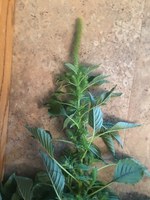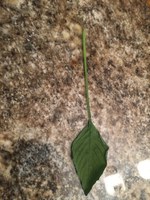Palmer Amaranth Confirmed in N.D.
(Click an image below to view a high-resolution image that can be downloaded)
-

This Palmer amaranth plant was the first one found in North Dakota. (Photo courtesy of Bruce Kusler, farmer and Pioneer seed salesman) -

One way to distinguish a Palmer amaranth plant is that its leaf stem is as long as or longer than the leaf blade. (Photo courtesy of Bruce Kusler, farmer and Pioneer seed salesman)
Palmer amaranth, a very aggressive weed, has been found in North Dakota for the first time.
Laboratory analysis has confirmed that a plant found in a row-crop field in McIntosh County in southcentral North Dakota is Palmer amaranth.
“A diligent farmer was scouting his field and doing some hand-weeding when he came across plants that looked unusual and wondered if they could be Palmer amaranth,” says North Dakota State University weed scientist Brian Jenks.
The farmer pulled the plants to keep them from going to seed. He showed the plants to a local agronomist, who contacted NDSU weed specialists for confirmation.
“We commend this farmer for being actively aware of the weeds in his field,” Jenks adds. “This is the type of awareness and diligence needed to keep this weed from having any impact in the state.”
Palmer amaranth, the No. 1 weed problem in the U.S., is a type of pigweed that originated in the desert region of the southwestern U.S. (New Mexico and Arizona) and northern Mexico, then spread to the Mississippi Delta before invading Missouri, Kansas, Iowa, Wisconsin, Minnesota and South Dakota, as well as other states.
The plant in McIntosh County likely came from seeds dropped by migratory birds, according to NDSU Extension sugar beet agronomist Tom Peters.
Palmer amaranth poses a serious threat to North Dakota crops because it can grow 2 to 3 inches per day in optimum conditions and reach a height of 6 to 8 feet. A single plant can produce up to 1 million seeds. Especially heavy infestations have reduced yield up to 79 percent in soybeans and 91 percent in corn.
Palmer amaranth is extremely hard to control because it is prone to being resistant to several herbicides. Applying herbicides before the weed emerges is more effective than trying to control it with herbicides after it has started growing, Peters says.
Unlike other annual weeds that need to be controlled only through early summer, Palmer amaranth emerges throughout the growing season, notes Jenks.
Peters and Jenks say the best way to keep Palmer amaranth from spreading is to look for it.
Identifying Palmer amaranth can be difficult because it resembles redroot pigweed, Powell amaranth and waterhemp. One of the best ways to distinguish Palmer amaranth from the other weeds is its leaf stem, or petiole, Peters says. Palmer amaranth’s petiole is as long as or longer than the leaf blade.
Another clue is Palmer amaranth’s distinctive, long, snaky seed heads. The seed heads can grow up to 2 feet long.
Visit NDSU Extension’s Palmer amaranth website at https://www.ag.ndsu.edu/palmeramaranth to learn more about the weed and how to identify it.
Farm equipment, wildlife, water and wind are among the ways Palmer amaranth seeds can spread. In other states, seeds also have been found in native seed mixes used for pollinator or wildlife habitats and in potting soil and hay. A lot of donated hay came into North Dakota in 2017 because of the severe drought the state was experiencing, so producers need to be on the lookout for Palmer amaranth and other weeds, Jenks and Peters say.
Gardeners also need to keep in mind that the potting soil they buy in North Dakota likely was bagged elsewhere and it may contain contaminants such as Palmer amaranth seeds, Peters adds.
Anyone who sees a plant that may be Palmer amaranth should contact a local NDSU Extension agent as soon as possible. Visit https://www.ag.ndsu.edu/extension/directory for contact information.
“This weed is a game changer and will be controlled only by a zero-tolerance policy,” Jenks says.
NDSU Agriculture Communication - Aug. 28. 2018
| Source: | Tom Peters, 701-231-8131, thomas.j.peters@ndsu.edu |
|---|---|
| Source: | Brian Jenks, 701-857-7677, brian.jenks@ndsu.edu |
| Editor: | Ellen Crawford, 701-231-5391, ellen.crawford@ndsu.edu |

